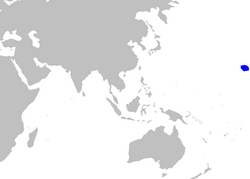Biology:Hawaiian lanternshark
| Hawaiian lanternshark | |
|---|---|

| |
| Scientific classification | |
| Domain: | Eukaryota |
| Kingdom: | Animalia |
| Phylum: | Chordata |
| Class: | Chondrichthyes |
| Subclass: | Elasmobranchii |
| Subdivision: | Selachimorpha |
| Order: | Squaliformes |
| Family: | Etmopteridae |
| Genus: | Etmopterus |
| Species: | E. villosus
|
| Binomial name | |
| Etmopterus villosus C. H. Gilbert, 1905
| |

| |
| Range of the Hawaiian lanternshark (in blue) | |
The Hawaiian Lanternshark (Etmopterus villosus) is a species of small squaliform shark in the family Etmopteridae.
Description
This type of Etmopteridae have a small but sturdy body. Research has found that females will reach to about 652 mm (25.7 in) in length, while males will reach about 624 mm (24.6 in) in length.[2] The Hawaiian lantern shark has a muted color range consisting of browns and blacks on its upper half of its body. While the lower part are more consistent with a darker tonal range. A couple of noticeable characteristics for this organism is upon the area above the pelvic fin there is a black mark, there gills are about 6.25 mm (0.246 in) long. Another couple of noticeable characteristics is the second dorsal fin. It is larger than the first frontal fin, but the length is almost half the size of the other. Another noticeable characteristic unique to the lanternshark is that the spine has a slight curve to it instead of being straight.[3]
Distribution
These organisms can be found in the Hawaiian islands arounds depths of 1.61 km (1.00 mi).[4] Some can be located more along the further of the Hawaiian island chain to the north. Researchers have found specimens near the Koko seamount and South Kanmu seamounts.[5]
Human interaction and preservation
Due to such depths that these creature live at, the interaction with human is sparse. The only rare occasion that humans end up encountering such deep sea sharks is the use of deep sea nets that impeach upon the sharks depth.[5] This also makes it not in the endangered species list.
References
- ↑ Finucci, B.; Cheok, J.; Cotton, C.F.; Kulka, D.W.; Neat, F.C.; Rigby, C.L.; Tanaka, S.; Walker, T.I. (2020). "Etmopterus villosus'". IUCN Red List of Threatened Species 2020: e.T161441A124486127. doi:10.2305/IUCN.UK.2020-3.RLTS.T161441A124486127.en. https://www.iucnredlist.org/species/161441/124486127. Retrieved 18 November 2021.
- ↑ "Etmopterus villosus Gilbert, 1905". Jürgen Pollerspöck & Nicolas Straube. https://shark-references.com/species/view/Etmopterus-villosus.
- ↑ "Hawaiian Lanternshark". Planet Shark Divers. https://planetsharkdivers.com/hawaiian-lanternshark/.
- ↑ "Hawaiian Lanternshark". Sharkwater Productions - The Truth Will Surface. https://www.sharkwater.com/shark-database/sharks/hawailian-lanternshark/.
- ↑ 5.0 5.1 Ebert, David; Papastamatiou, Yannis; Kajiura, Stephan; Wetherbee, Bradley (February 2017). "Etmopterus lailae sp. nov., a new lanternshark (Squaliformes: Etmopteridae) from the Northwestern Hawaiian Islands". Zootaxa: 378. doi:10.11646/zootaxa.4237.2.10. https://www.researchgate.net/publication/314103176_Etmopterus_lailae_sp_nov_a_new_lanternshark_Squaliformes_Etmopteridae_from_the_Northwestern_Hawaiian_Islands. Retrieved 11 October 2022.
Wikidata ☰ Q3761462 entry
 |


